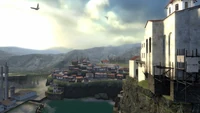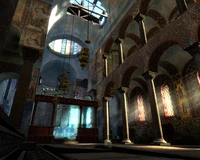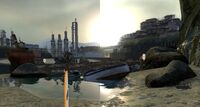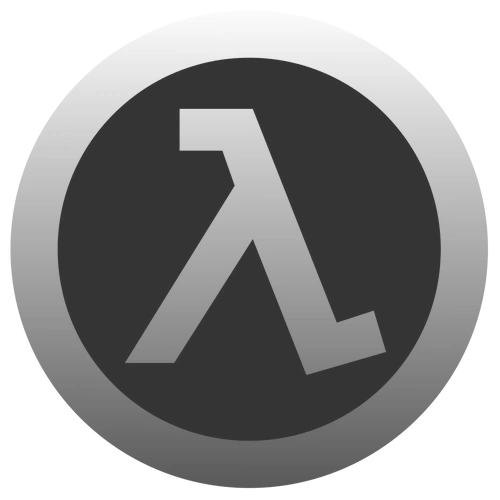No edit summary |
|||
| (46 intermediate revisions by 21 users not shown) | |||
| Line 1: | Line 1: | ||
| − | {{Article|rw|hl2 |
+ | {{DISPLAYTITLE:''Half-Life 2: Lost Coast''}}{{Article|rw|hl2}} |
{{Cleanup}} |
{{Cleanup}} |
||
| − | {{ |
+ | {{Needsimages}} |
{{Spoiler}} |
{{Spoiler}} |
||
| + | {{Noncanon}} |
||
| − | {{Game_Infobox |
||
| + | {{Game Infobox |
||
|image=[[File:Lost Coast logo.jpg|250px]] |
|image=[[File:Lost Coast logo.jpg|250px]] |
||
|name=Half-Life 2: Lost Coast |
|name=Half-Life 2: Lost Coast |
||
| Line 11: | Line 12: | ||
|genre=[[Wikipedia:First-person shooter|First-person shooter]] [[Wikipedia:Tech demo|Tech demo]] |
|genre=[[Wikipedia:First-person shooter|First-person shooter]] [[Wikipedia:Tech demo|Tech demo]] |
||
|mode=[[Wikipedia:Single-player video game|Single-player]] |
|mode=[[Wikipedia:Single-player video game|Single-player]] |
||
| − | |platform=[[Wikipedia:Microsoft Windows|Microsoft Windows]] |
+ | |platform=[[Wikipedia:Microsoft Windows|Microsoft Windows]], [[Wikipedia:Linux|Linux]] |
|hidep= |
|hidep= |
||
|hideu= |
|hideu= |
||
|rating= |
|rating= |
||
| − | |distribution=[[Steam]] |
+ | |distribution=[[Wikipedia:Steam (software)|Steam]] |
|system=''[[Half-Life 2]]'', 2.9 [[Wikipedia:Hertz|GHz]] [[Wikipedia:Central processing unit|processor]], 1 [[Wikipedia:Gigabyte|GB]] [[Wikipedia:Random access memory|RAM]], [[Wikipedia:DirectX|DirectX]] 9 compatible card |
|system=''[[Half-Life 2]]'', 2.9 [[Wikipedia:Hertz|GHz]] [[Wikipedia:Central processing unit|processor]], 1 [[Wikipedia:Gigabyte|GB]] [[Wikipedia:Random access memory|RAM]], [[Wikipedia:DirectX|DirectX]] 9 compatible card |
||
|input=[[Wikipedia:Keyboard (computing)|Keyboard]] and [[Wikipedia:Mouse (computing)|mouse]] |
|input=[[Wikipedia:Keyboard (computing)|Keyboard]] and [[Wikipedia:Mouse (computing)|mouse]] |
||
| Line 27: | Line 28: | ||
}} |
}} |
||
| + | '''''Half-Life 2: Lost Coast''''' is a technology demo showing off the [[Source]] engine's HDR rendering capabilities. The town of [[St. Olga]], where the game is set, was originally slated to take place between the levels ''[[Half-Life 2 storyline#Highway 17|Highway 17]]'' and ''[[Half-Life 2 storyline#Sandtraps|Sandtraps]]'', but was dropped. ''Lost Coast'' was released on October 27, 2005<ref>[http://store.steampowered.com/app/340/ ''Lost Coast''] on [[Wikipedia:Steam (software)|Steam]]</ref> as a free download to all owners of ''[[Half-Life 2]]''. |
||
| − | '''''Half-Life 2: Lost Coast''''' is a small additional level for the 2004 first-person shooter video game [[Half-Life 2]]. Developed by Valve Software, it was released on October 27, 2005, through the [[Steam]] content delivery service as a free download to owners of the Microsoft Windows version of [[Half-Life 2]]. Lost Coast serves as a technology demonstration, specifically showcasing the high dynamic range rendering implemented in the [[Source]] engine. The level was designed with a variety of appropriate environments to emphasize these effects. In addition, Lost Coast was the first video game developed by Valve to allow developers to explain various elements of design as the player progresses through the level. |
||
| − | |||
| − | Lost Coast follows Half-Life protagonist [[Gordon Freeman]] as he travels up a coastal cliff to destroy a [[Combine]] artillery launcher in a monastery, which is firing on a nearby town. The Lost Coast level was originally created for Half-Life 2, but was ultimately removed from the game. As a result, it has several minor story details that were not included in [[Half-Life 2]]. The level received a generally positive reception, and there was consensus among reviewers that the new features included in Lost Coast should be integrated into future games released by Valve. |
||
==Plot== |
==Plot== |
||
| − | + | The level begins with [[Gordon Freeman]] waking up, after having apparently fallen close to several decaying piers underneath the shadow of a large Byzantine-style church set up on a large outcrop of rock overlooking the coastal town of [[St. Olga]] (a loud splash can be heard shortly before Gordon awakes). |
|
| + | |||
| + | An unnamed man (referred to in the commentary as "[[The Fisherman]]") standing on a dock recognizes the player as Gordon, although he cannot accurately remember his name, and tells him that the [[Combine]] have made a base in the area. He lets Gordon through a gate and tells him to "take out that gun". |
||
| − | The |
+ | The gate leads to a winding path along the side of the outcrop the church is located. The player soon encounters resistance in the form of [[Overwatch Soldier]]s, some of whom rappel from the cliffs above. As he proceeds up the cliff, a launcher based in the church at the top begins bombarding the nearby town with [[Headcrab Shell|headcrab shells]]. Upon reaching the top of the cliff, the player finds the church and its courtyard unguarded. The church itself is relatively undamaged except for the religious paintings on the walls, the faces of all but a few of the characters having been rubbed away. |
[[File:LostCoast.jpg|thumb|200px|left|St. Olga and the monastery.]] |
[[File:LostCoast.jpg|thumb|200px|left|St. Olga and the monastery.]] |
||
| − | On one wall of the structure, the Combine have constructed the shell launcher. At a regular interval shells are loaded into the chamber and launched at the town. When the player destroys the launcher by jamming the mechanism with debris, an alarm is triggered, prompting the Combine to launch a second attack on the church itself, with a [[Hunter-Chopper]] acting as air support. The player must fight their way out of the church and shoot down the Hunter-Chopper with an [[Resistance RPG|RPG]]. After completing the task, the player must ride an elevator back down to the docks to meet The Fisherman |
+ | On one wall of the structure, the Combine have constructed the shell launcher. At a regular interval shells are loaded into the chamber and launched at the town. When the player destroys the launcher by jamming the mechanism with debris, an alarm is triggered, prompting the Combine to launch a second attack on the church itself, with a [[Hunter-Chopper]] acting as air support. The player must fight their way out of the church and shoot down the Hunter-Chopper with an [[Resistance RPG|RPG]]. After completing the task, the player must ride an elevator back down to the docks to meet The Fisherman, at which point the level fades to black. |
| − | |||
| − | == Development == |
||
| − | |||
| − | '''Level design''' |
||
| − | |||
| − | Half-Life 2 Lost Coast was originally conceived as a level in [[Half-Life 2]], but was later discarded during development. As a result, Lost Coast features minor storyline details that were removed from [[Half-Life 2]], such as the [[Headcrab]] artillery launchers. Each area of the level was designed with a specific purpose. An Eastern Orthodox architectural style was deliberately chosen for the monastery, as buildings of this type "are very colorful and have a large variety of materials" and are "often lit naturally, with extremes of darkness and brightness," providing an ideal showcase for the HDR lighting effects. Valve also thought that the use of a monastery would help provide a starker contrast between old human architecture and futuristic [[Combine]] technology found within it. The cliffside that leads to the monastery had a gameplay-oriented purpose, and was meant to emulate a similar cliffside combat scene in Half-Life. The cliffside also forces the player to be observant of threats from above and below, breaking from normal horizontal combat. The monastery's courtyard was designed as an area where the player recovers from the cliffside combat, while also presenting a contained combat arena later in the level in which the player must hold their ground while they are attacked from multiple directions. |
||
| − | |||
| − | '''High dynamic range rendering''' |
||
| − | |||
| − | The goal of Lost Coast was to demonstrate the new high dynamic range (HDR) rendering implemented into the [[Source]] game engine. Valve first attempted to implement HDR rendering in Source in late 2003. The first method stored textures in RGBA color space, allowing for multisample anti-aliasing and pixel shaders to be used, but this prevented alpha mapping and fog effects from working properly, as well as making textures appear sharp and jagged. The second method involved saving two versions of a texture: one with regular data, and the other with overbrightening data. However, this technique did not allow for multisample anti-aliasing and consumed twice as much video card memory, making it unfeasible. The third method, shown at the E3 convention in 2005, used floating point data to define the RGB color space, allowing for reasonably efficient storage of the HDR data. However, this method also did not allow for multisample anti-aliasing, and was only compatible with Nvidia video cards, leaving ATI cards unable to run HDR.The fourth and final method compromised between the second and third methods, using overbrightening textures sparingly and allowing ATI cards to render HDR in a different way to the Nvidia ones while nearly producing the same end result. |
||
| − | |||
| − | The final version of Valve's HDR technology adds a significant number of lighting effects to the engine, aimed at making the game appear more realistic. Bloom shading was introduced, blurring bright edges in the game world and emulating a camera's overexposure to light. This is combined with exposure control to tailor the effect to represent the human eye. For example, as the player exits a dark area into a light area, the new area is initially glaringly bright, but quickly darkens, representing the adjustment of the player character's eyes to the light. New cube mapping techniques allow the reflection cast by an object to correspond with the brightness of the light source, and lightmaps enable light bouncing and global illumination to be taken into account in the rendering. Refraction effects were added to make light account for the physical attributes of an object and to emulate the way light is reflected by water. The Lost Coast level is specifically designed to showcase these effects. It uses the sea and beach as opportunities to demonstrate water-based effects, the monastery to demonstrate bloom from its whitewash walls, and the sanctuary to provide the means to show refraction through stained glass windows and cube maps on golden urns and candlesticks. |
||
| − | |||
| − | As a technology showcase, Valve considered Lost Coast to have very demanding system requirements. The game runs on computers with specifications lower than what is recommended, albeit without some key features such as HDR. If a non-HDR capable card is used, the developer commentary is changed slightly to reflect this. For example, [[Gabe Newell]] would describe the effects that are seen in a different manner. |
||
==Developer commentary== |
==Developer commentary== |
||
| − | Aside from visual fidelity and HDR, ''Lost Coast'' also acted as a testbed for a commentary system<ref>[http://www.steampowered.com/Steam/Marketing/August5.2005/?l=english Friday, August 5, 2005 Update] on [[Steam]]</ref> where, when the option is enabled, additional items appear in-game that can be interacted with to play audio commentary, each piece ranging anywhere from ten seconds to a minute of commentary. Players will hear the developers talk about what they are seeing, what is happening, why the team chose to do what they did, what kind of challenges they faced, and so on. Commentary tracks are represented by floating speech bubbles known as [[Developer commentary|commentary nodes]]. To listen to a commentary track, the player must place the crosshairs over it, and presses the <code>USE</code> key. Doing the same again will stop the commentary track. Commands can be run when a commentary track starts and stops; in ''Lost Coast'', this is used to completely disable the AI while the track plays. However, in ''[[Half-Life 2: Episode One]]'', running a commentary track renders the player invulnerable to in-game damage for the time being rather than disabling the AI. |
+ | Aside from visual fidelity and HDR, ''Lost Coast'' also acted as a testbed for a commentary system<ref>[http://www.steampowered.com/Steam/Marketing/August5.2005/?l=english Friday, August 5, 2005 Update] on [[Wikipedia:Steam (software)|Steam]]</ref> where, when the option is enabled, additional items appear in-game that can be interacted with to play audio commentary, each piece ranging anywhere from ten seconds to a minute of commentary. Players will hear the developers talk about what they are seeing, what is happening, why the team chose to do what they did, what kind of challenges they faced, and so on. Commentary tracks are represented by floating speech bubbles known as [[Developer commentary|commentary nodes]]. To listen to a commentary track, the player must place the crosshairs over it, and presses the <code>USE</code> key. Doing the same again will stop the commentary track. Commands can be run when a commentary track starts and stops; in ''Lost Coast'', this is used to completely disable the AI while the track plays. However, in ''[[Half-Life 2: Episode One]]'', running a commentary track renders the player invulnerable to in-game damage for the time being rather than disabling the AI. |
Valve has added the commentary system to all subsequent games. |
Valve has added the commentary system to all subsequent games. |
||
| Line 64: | Line 51: | ||
[[File:HDR conventional.jpg|thumb|200px|right|On the left: Standard rendering. On the right: HDR rendering.]] |
[[File:HDR conventional.jpg|thumb|200px|right|On the left: Standard rendering. On the right: HDR rendering.]] |
||
| − | * '''Processor:''' [[Wikipedia:Pentium 4|Pentium 4]] 2. |
+ | * '''Processor:''' [[Wikipedia:Pentium 4|Pentium 4]] 2.4 GHz or [[Wikipedia:AMD|AMD]] 2800+ |
| − | * '''Memory:''' 1 GB [[Wikipedia:RAM|RAM]]. |
+ | * '''Memory:''' 1 GB [[Wikipedia:RAM|RAM]]. |
* '''Graphics Card:''' [[Wikipedia:DirectX|DirectX]] 9 native |
* '''Graphics Card:''' [[Wikipedia:DirectX|DirectX]] 9 native |
||
* 335 [[Wikipedia:Megabyte|MB]] disk space (with ''Half-Life 2'' installed) |
* 335 [[Wikipedia:Megabyte|MB]] disk space (with ''Half-Life 2'' installed) |
||
| Line 78: | Line 65: | ||
==Trivia== |
==Trivia== |
||
*The Fisherman does not have a physics model and, if killed, he will either crash the game or he will do a reference pose. |
*The Fisherman does not have a physics model and, if killed, he will either crash the game or he will do a reference pose. |
||
| + | |||
| + | *The [[Combine Gunship]] can be found by no-clipping before the [[Hunter Chopper]] attacks. |
||
*The [[Hunter-Chopper]] that opposes the player towards the end of the demo behaves and even sounds like the [[Combine Gunship]]; it shoots down incoming rockets and its pulse gun is much more accurate. |
*The [[Hunter-Chopper]] that opposes the player towards the end of the demo behaves and even sounds like the [[Combine Gunship]]; it shoots down incoming rockets and its pulse gun is much more accurate. |
||
| Line 87: | Line 76: | ||
*The shell launcher, despite its printed warning sign stating that its moving parts can crush objects, can be disabled with any available physics object small enough to pick up and fit into it. Oddly enough, it cannot be destroyed with a grenade or any other weapon. |
*The shell launcher, despite its printed warning sign stating that its moving parts can crush objects, can be disabled with any available physics object small enough to pick up and fit into it. Oddly enough, it cannot be destroyed with a grenade or any other weapon. |
||
| − | *''Half-Life 2: Lost Coast'' is currently the only game to not get updated to use Source Engine version 15. |
+ | *''Half-Life 2: Lost Coast'' is currently the only game to not get updated to use Source Engine version 15. However, if the Steampipe Beta is activated, the Source Engine version 24. |
| + | |||
| + | *The game is included with the purchase of ''Half-Life 2''. |
||
==References== |
==References== |
||
| Line 95: | Line 86: | ||
==External links== |
==External links== |
||
| − | *{{Steam| |
+ | *{{Steam|app/340|Half-Life 2: Lost Coast}} |
*[http://www.eurogamer.net/article.php?article_id=58580 EuroGamer ''Half-Life 2: Lost Coast'' preview] |
*[http://www.eurogamer.net/article.php?article_id=58580 EuroGamer ''Half-Life 2: Lost Coast'' preview] |
||
*[http://www.bit-tech.net/gaming/2005/06/14/hl2_hdr_overview/1.html bit-tech.net ''Half Life 2: Lost Coast'' HDR overview] |
*[http://www.bit-tech.net/gaming/2005/06/14/hl2_hdr_overview/1.html bit-tech.net ''Half Life 2: Lost Coast'' HDR overview] |
||
| Line 102: | Line 93: | ||
{{RW}} |
{{RW}} |
||
| + | [[ru:Half-Life 2: Lost Coast]] |
||
[[Category:Games]] |
[[Category:Games]] |
||
[[Category:Half-Life 2]] |
[[Category:Half-Life 2]] |
||
[[Category:Half-Life 2: Lost Coast]] |
[[Category:Half-Life 2: Lost Coast]] |
||
[[Category:Cut content]] |
[[Category:Cut content]] |
||
| + | [[Category:Technology demos]] |
||
Revision as of 01:05, 8 November 2018
| You can help by correcting spelling and grammar, removing factual errors, rewriting sections to ensure they are clear and concise, and moving some elements when appropriate. Visit our Cleanup Project for more details and, please, notify the administrators before removing this template. |
| To illustrate the article add one or more relevant images or upload them from canonical / official sources. For more instructions visit Half-Life Wiki:Images. |
Half-Life 2: Lost Coast is a technology demo showing off the Source engine's HDR rendering capabilities. The town of St. Olga, where the game is set, was originally slated to take place between the levels Highway 17 and Sandtraps, but was dropped. Lost Coast was released on October 27, 2005[1] as a free download to all owners of Half-Life 2.
Plot
The level begins with Gordon Freeman waking up, after having apparently fallen close to several decaying piers underneath the shadow of a large Byzantine-style church set up on a large outcrop of rock overlooking the coastal town of St. Olga (a loud splash can be heard shortly before Gordon awakes).
An unnamed man (referred to in the commentary as "The Fisherman") standing on a dock recognizes the player as Gordon, although he cannot accurately remember his name, and tells him that the Combine have made a base in the area. He lets Gordon through a gate and tells him to "take out that gun".
The gate leads to a winding path along the side of the outcrop the church is located. The player soon encounters resistance in the form of Overwatch Soldiers, some of whom rappel from the cliffs above. As he proceeds up the cliff, a launcher based in the church at the top begins bombarding the nearby town with headcrab shells. Upon reaching the top of the cliff, the player finds the church and its courtyard unguarded. The church itself is relatively undamaged except for the religious paintings on the walls, the faces of all but a few of the characters having been rubbed away.

St. Olga and the monastery.
On one wall of the structure, the Combine have constructed the shell launcher. At a regular interval shells are loaded into the chamber and launched at the town. When the player destroys the launcher by jamming the mechanism with debris, an alarm is triggered, prompting the Combine to launch a second attack on the church itself, with a Hunter-Chopper acting as air support. The player must fight their way out of the church and shoot down the Hunter-Chopper with an RPG. After completing the task, the player must ride an elevator back down to the docks to meet The Fisherman, at which point the level fades to black.
Developer commentary
Aside from visual fidelity and HDR, Lost Coast also acted as a testbed for a commentary system[2] where, when the option is enabled, additional items appear in-game that can be interacted with to play audio commentary, each piece ranging anywhere from ten seconds to a minute of commentary. Players will hear the developers talk about what they are seeing, what is happening, why the team chose to do what they did, what kind of challenges they faced, and so on. Commentary tracks are represented by floating speech bubbles known as commentary nodes. To listen to a commentary track, the player must place the crosshairs over it, and presses the USE key. Doing the same again will stop the commentary track. Commands can be run when a commentary track starts and stops; in Lost Coast, this is used to completely disable the AI while the track plays. However, in Half-Life 2: Episode One, running a commentary track renders the player invulnerable to in-game damage for the time being rather than disabling the AI.
Valve has added the commentary system to all subsequent games.
Recommended system specifications

Inside the monastery's church.

On the left: Standard rendering. On the right: HDR rendering.
- Processor: Pentium 4 2.4 GHz or AMD 2800+
- Memory: 1 GB RAM.
- Graphics Card: DirectX 9 native
- 335 MB disk space (with Half-Life 2 installed)
Lost Coast is a 98 MB compressed download from Steam.
Despite some claims, Lost Coast can run on computers with specifications lower than those listed above, albeit without some of the key visual features, such as HDR. It should be noted that a computer with the bare minimum specifications to run Half-Life 2 will not be able to run Lost Coast.
Behind the scenes
- The subtitles file indicates that the game was intended to be longer, with The Fisherman staying with the player for a longer time and mentioning Bullsquids.
Trivia
- The Fisherman does not have a physics model and, if killed, he will either crash the game or he will do a reference pose.
- The Combine Gunship can be found by no-clipping before the Hunter Chopper attacks.
- The Hunter-Chopper that opposes the player towards the end of the demo behaves and even sounds like the Combine Gunship; it shoots down incoming rockets and its pulse gun is much more accurate.
- The Fisherman is the first Source character whose face was made from scratch without a real-life model.
- In the Source SDK Base, a flyby of this level can be launched as a video stress test.
- The shell launcher, despite its printed warning sign stating that its moving parts can crush objects, can be disabled with any available physics object small enough to pick up and fit into it. Oddly enough, it cannot be destroyed with a grenade or any other weapon.
- Half-Life 2: Lost Coast is currently the only game to not get updated to use Source Engine version 15. However, if the Steampipe Beta is activated, the Source Engine version 24.
- The game is included with the purchase of Half-Life 2.
References
External links
 Half-Life 2: Lost Coast on the Steam Store
Half-Life 2: Lost Coast on the Steam Store- EuroGamer Half-Life 2: Lost Coast preview
- bit-tech.net Half Life 2: Lost Coast HDR overview
- bit-tech.net Half-Life 2: Lost Coast playtest
- bit-tech.net Half-Life 2: Lost Coast benchmark
| Companies | Gearbox Software • Junction Point Studios • Valve Corporation |
|---|---|
| Production staff | Artists • Character models • Composers • Voice actors • Writers • Other |
| Software | Achievements • Compilations • Demos • Games (Half-Life • Multiplayer • Non-canon • Portal • Third-party) • Game Engines • HL HD Pack • Mods |
| Other Media | ApertureScience.com • Books (Lab Rat • Raising the Bar) • Fan content (Films • Games • Mods • Series) • Films • Merchandise • Preliminary Findings • Soundtracks (Songs • Composers) • The Final Hours (Half-Life • Half-Life 2 • Half-Life: Alyx • Portal 2) |
| Cut content | Prospero • Half-Life Alpha • Half-Life 2 Beta • Half-Life 2: Episode Three • Half-Life 2: Episode Four |
| Misc. | Canon • Development (Commentary • Half-Life 2 • Portal • Next Half-Life game) • Mr. Valve • Retcons |
